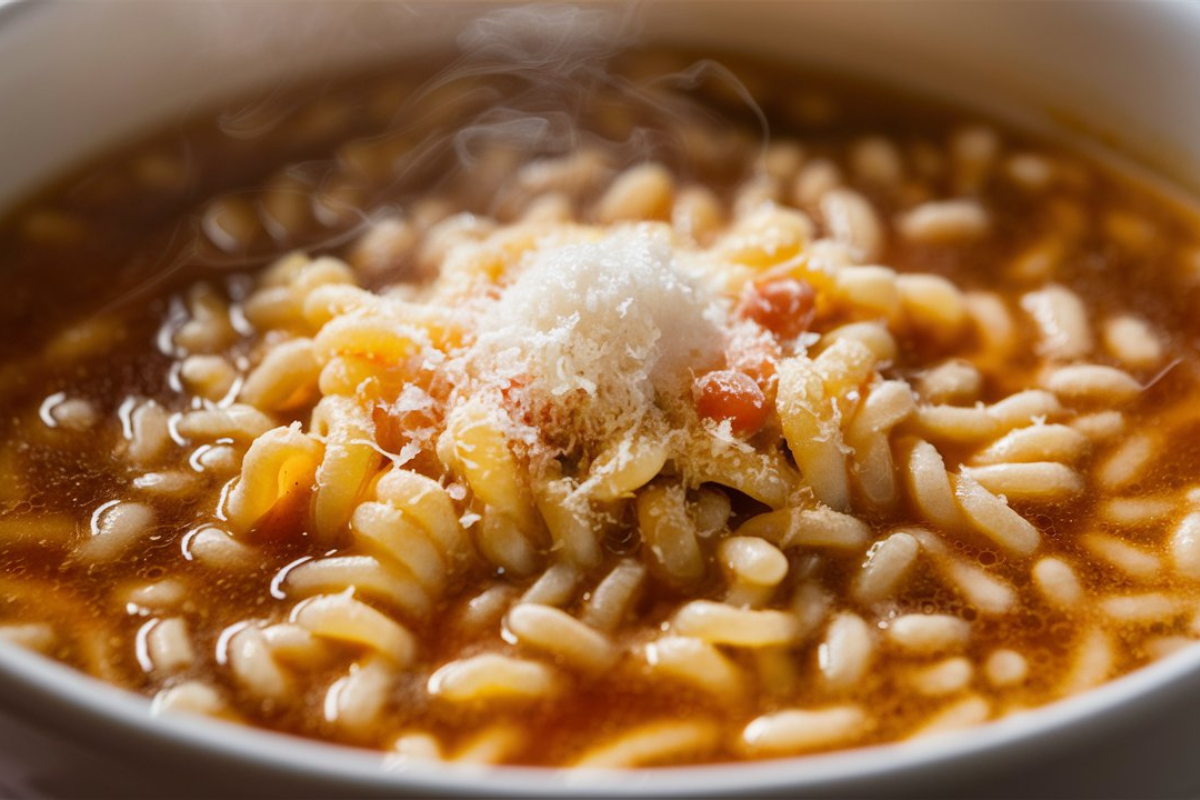Pastina, the small star-shaped pasta, is a cherished staple in Italian homes, especially valued as comfort food. This seemingly modest dish carries deep cultural importance and personal significance, endearing itself to many hearts.
Introduction and Basics
What is Pastina?
Definition and Origin
Pastina, meaning “little pasta” in Italian, consists of tiny star-shaped or rice-shaped pieces of pasta. Originating in Italy, pastina serves as a staple in Italian households and is often the first solid food given to babies. Its small size allows for easy cooking and digestion, which is why many use it in soups and simple pasta dishes.
Common Uses in Cooking
Pastina offers incredible versatility in the kitchen. Many cooks use it in soups, where it adds a comforting texture without overpowering other ingredients. A quick, nourishing meal can be made by cooking pastina simply with butter and cheese. It easily absorbs the flavors of the ingredients it’s cooked with, making it a favorite for both simple and complex dishes.
Cultural Significance
Pastina holds a special place in many cultures, particularly in Italian and Italian-American households. Many associate it with childhood and comfort, evoking memories of family meals and care during illness. This cultural connection adds to the emotional comfort that people experience when eating pastina. Its preparation and consumption often signify acts of love and nurturing, further enhancing its status as a comfort food.
Personal Stories and Memories of Pastina
Pastina, often recognized as more than just a meal, embodies a symbol of warmth and nurturing, especially in Italian culture. This tiny, star-shaped pasta serves not only as a comfort food but also as a vessel for cherished memories. From being a first food for many Italian children to a comforting remedy during illness, pastina holds a special place in many hearts.
Childhood Comfort
For countless individuals, pastina represents a nostalgic journey back to simpler times. It is the taste of childhood, where each spoonful offered warmth and safety. Whether it was served by grandparents with a pat of butter and a sprinkle of cheese or by a parent trying to soothe a sore throat, pastina was there, gentle and easy to digest.
- Morning Rituals: Many recall waking up to a warm bowl of pastina at their grandmother’s kitchen table, the steam rising off the bowl mingling with the morning light.
- Sick Days: Pastina was the go-to meal during sick days. Its soothing texture and simplicity made it the perfect dish for unsettled stomachs and low appetites.
Recipes Passed Down Through Generations
Cultural Significance of Pastina in Italian Cuisine
A Culinary Tradition
In Italy, pastina is more than a dish—it’s a cultural icon, deeply embedded in the culinary practices that define family life. Its role in Italian cuisine can be seen through various lenses:
- Infant’s Introduction to Food: Pastina is often chosen as the ideal first food for babies due to its soft texture and ease of digestion. It serves as a gentle introduction to the world of solids.
- Comfort Food: Across Italy, pastina is synonymous with comfort. It is the go-to dish for mothers looking to quickly appease hungry children or for anyone seeking a simple, soothing meal during illness or cold weather.
Pastina in Italian Festivities
Pastina also plays a role in Italian festive traditions, acting as a versatile base that you can dress up for celebrations or simplify for a comforting meal at home.
- Holiday Meals: During holidays, chefs often enrich pastina with luxurious broths and ingredients like truffles or high-quality cheese, which transforms it from a simple everyday dish to a festive delicacy.
- Symbol of Hospitality: When hosts offer pastina to guests, they actively demonstrate hospitality, providing a warm and nourishing meal that evokes a sense of home and heartiness.
Symbolic Meanings
The simplicity of pastina belies its depth of significance in Italian culture, where food is often laden with symbolic meanings.
- Symbol of Simplicity and Purity: Pastina embodies simplicity and purity in Italian culinary philosophy. It highlights a preference for quality ingredients and dishes.
- Connector of Generations: Pastina serves as a bridge between old and new. Families often pass down recipes and techniques, usually unchanged.
Regional Variations
Pastina is popular across Italy, with regional variations that reflect local flavors and customs. This simple pasta adapts to the tastes and ingredients of each area.
- North vs. South: In the north, pastina is often served in rich, meat-based broths. In the south, it’s typically lighter, frequently in vegetable or fish broths.
- Local Ingredients: Regions may add local cheeses, herbs, or vegetables, making each pastina dish a reflection of its locality.
The cultural significance of pastina in Italian cuisine is profound. It embodies the essence of Italian cooking—flavorful yet straightforward, rich in history yet adaptable to the modern table. Pastina continues to be a beloved part of Italian culinary heritage, cherished for its ability to convey comfort, tradition, and the simple joys of eating. Discover what is so special about pastina on our blog.
Health Benefits and Nutritional Value of Pastina
Basic Nutrients in Pastina
Pastina is a source of essential nutrients, including carbohydrates, proteins, and a small amount of fat. These nutrients provide the energy needed for daily activities and support overall health. While pastina is not particularly high in fiber, it can be paired with vegetables and lean proteins to create a more balanced meal. Understanding the nutritional content of pastina can help you incorporate it into a healthy diet.
Vitamins and Minerals
Pastina contains several important vitamins and minerals, including B vitamins (such as folate and niacin), iron, and magnesium. These nutrients play crucial roles in energy metabolism, red blood cell production, and maintaining healthy muscles and nerves. Although pastina may not be a nutritional powerhouse on its own, it can be part of a nutritious meal when combined with other nutrient-dense ingredients.
Health Benefits
Energy Boosting Carbohydrates
Pastina is rich in carbohydrates, which are the body’s primary source of energy. These carbohydrates are easily broken down into glucose, which fuels the brain, muscles, and other vital organs. For children and adults alike, a bowl of pastina can provide a quick and effective energy boost, especially when combined with other nutritious ingredients like vegetables and lean proteins. This makes pastina an excellent choice for breakfast or lunch, providing sustained energy throughout the day. Additionally, the simple carbohydrates in pastina are easy to digest, making it suitable for those needing a quick energy source without taxing their digestive system.
Role in a Balanced Diet
Incorporating pastina into a balanced diet can help ensure you receive a variety of essential nutrients. While pastina itself is not particularly high in fiber or protein, it can be paired with other foods to create a nutritionally complete meal. For example, adding vegetables such as spinach, carrots, or peas can boost the fiber content, while incorporating lean proteins like chicken, turkey, or beans can enhance the meal’s protein profile. Healthy fats, such as olive oil or avocado, can also be added to provide essential fatty acids. By combining pastina with these nutrient-dense foods, you can create well-rounded dishes that support overall health and wellness.
Ease on the Digestive System
Pastina is gentle on the digestive system, making it an ideal food for those with sensitive stomachs or digestive issues. Its small size and simple composition mean it is less likely to cause gastrointestinal discomfort or exacerbate existing conditions. This makes pastina a popular choice for individuals recovering from illness or surgery, as well as for young children and the elderly. The ease of digestion allows the body to absorb the nutrients more efficiently, providing nourishment without straining the digestive tract. Additionally, the warm, soothing nature of pastina can help alleviate symptoms of nausea and promote a feeling of comfort and well-being.

